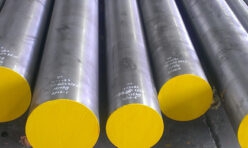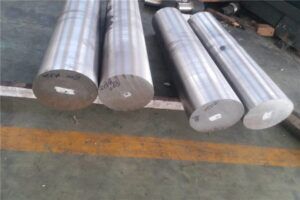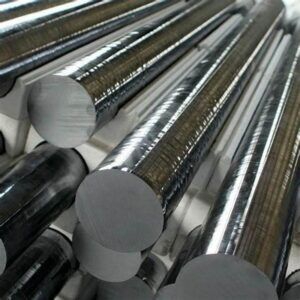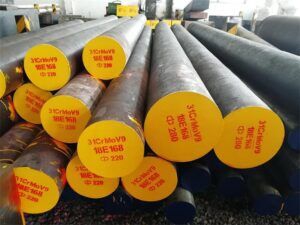1.4125 X105CrMo17 UNS S44004 440C Stainless Steel
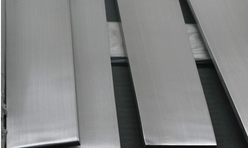
1.4125 X105CrMo17 UNS S44004 440C Stainless Steel
1 1.4125 Introduction:
440C stainless steel is a high carbon martensitic stainless steel. It has high strength, moderate corrosion resistance, and good hardness and wear resistance.
2 1.4125 Applications:
Suitable for applications requiring a combination of excellent wear resistance with moderate corrosion resistance, 440C stainless steel is commonly used in the oil and gas, marine, food and medical industries. Typical applications are pumps, valve components, bearings, knives, surgical tools, cutlery, bearings and races.
3 Quality Standard:
ASTM A276 Standard Specification for Stainless Steel Bars and Shapes
EN 10088 part3 stainless steel
4 All Grades Comparison:
| ASTM | DIN | UNS | EN |
|---|---|---|---|
| 440C | 1.4125 | S44004 | X105CrMo17 |
Smelting Option
1 EAF: Electric Arc Furnace
2 EAF+LF+VD: Refined-smelting and vacuum degassing
3 EAF+ESR: Electro Slag Remelting
4 EAF+PESR: protective atmosphere Electro Slag Remelting
5 VIM+PESR: Vacuum induction melting
Forming Option
1 Hot rolling process
2 Hot Forging: Electro-hydraulic; High-speed-hydraulic; Oil-hydraulic; Precision-forging
Heat-treatment Option
1 +A: Annealed (full/soft/spheroidizing)
2 +N: Normalized
3 +NT: Normalized and tempered
4 +QT: Quenched and tempered (water/oil)
5 +AT: Solution annealed
6 +P: Precipitation hardened
Suface Option
1 Black Surface
2 Grounded: Bright but rough ; Not precision
3 Machining for plate: Bright and precision; Little turning scar
4 Peeled/Turned: Bright and precision; Little turning scar
5 Polished: Very Bright and precision size; Not turning scar
Other Services
1 Cutting: Small pieces
2 CNC Machine: Produce as your drawing
3 Package: Bare/Nylon/Canvas/Wooden
4 Payment:T/T, L/C, O/A(request credit)
5 Transport:FOB/CFR/CIF/DDU/DDP (train/ship/Air)
5 1.4125 Chemical Composition(%):
| Steel Grade | C | Si | Mn | P | S | Cr | Mo |
|---|---|---|---|---|---|---|---|
| 440C | 0.95-1.20 | 1.0 max | 1.0 max | 0.040 max | 0.030 max | 16.0-18.0 | 0.75 max |
| 1.4125 | 0.95-1.20 | 1.0 max | 1.0 max | 0.040 max | 0.030 max | 16.00-18.00 | 0.40-0.60 |
6 Mechanical Properties (Annealed)
| Hardness (HB) |
|---|
| 285 max |
7 HEAT TREATMENT and FABRICATION:
Hot Working: 440C stainless steel is pre-heated at 760°C (1400°F). Temperature can be increased up to 1038-1204°C (1900-2200°F). It should not be heated below 927°C (1700°F). It is then slowly cooled at room temperature and fully annealed.
Cold Working: 440C stainless steel is slightly cold workable using common practices.
Forging: 440C stainless steel can be forged by heating slowly and uniformly to 1050-1150°C, allowing sufficient time for the steel to become heated through. Ensure not to overheat as this can cause a loss of toughness and ductility. Do not forge below 900°C reheating if necessary. After forging cool slowly in furnace or thermoinsulating material, then anneal immediately. Air cooling after forging may cause cracking.
Annealing: 440C stainless steel is annealed at 843-871°C (1550-1600°F) followed by slowly cooling in the furnace.
Hardening: 440C stainless steel can be hardened by heating at 760°C (1400°F). Temperature can be increased up to 1010°C (1850°F) followed by cooling in air or oil.
Tempering: 440C stainless steel can be tempered by soaking at 148°C (300°F).
Welding: 440C stainless steel is not welded because it can be easily air hardened. To weld this alloy, it should be preheated to 260°C (500°F) and post weld treated at 732-760°C (1350-1400°F) for 6 h followed by slowly cooling in the furnace to prevent cracking.
Machinability: 440C stainless steel can be machined in the annealed condition. Chip breakers can be used to handle tough and stringy chips. Carbide or ceramic tooling is preferred for this alloy.
8 Mill′s test certificate:
EN 10204/3.1 with all relevant data reg. chem. composition, mech. properties and results of testing.

